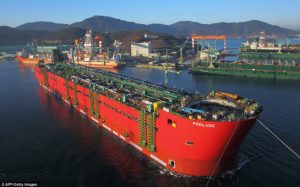
Last week, we explored a small company, Carib Energy Solutions, aiming to supply the Caribbean with LNG. We also briefly mentioned another company, Cambridge Energy and their plans to supply the Caribbean with LNG as well. However, unlike Carib, Cambridge is planning to produce their own LNG. Further, it is planning to produce LNG on two floating liquid natural gas (FLNG) platforms. Cambridge is not the only company aspiring to use FLNG to export natural gas from North America and is joined by several players including Excelerate Energy, Waller LNG, Pangea LNG, Delfin LNG, Main Pass Energy Hub and Eos LNG.
An FLNG platform has the production capabilities of traditional LNG train but instead of being land-based, the trains are water-based. There are a few key drivers for the use of FLNG platforms which we have perviously mentioned. First, they are able to relocate. Second, they can be constructed modularly, which can lead to lower costs. Last, they could presumably have a smaller environmental footprint due to being sea-based. Shell announced the world’s first FLNG project, Prelude, and took its final investment decision in 2011. Since then, construction has started and the hull was launched in 2013. The Prelude project is set to commence operations off the northwest coast of Australia in the Browse Basin in 2017.
Cambridge has received U.S. Department of Energy approval to export LNG to free trade agreement (FTA) countries but is waiting on approval for export to non-FTA countries along with Federal Energy Regulatory Commission approval to begin construction. Construction will occur two phases. Phase one will see the construction of a pipeline to feed the FLNG platforms and the construction of the marine terminals and phase two will have the mooring system and the actual FLNG platforms installed. Cambridge plans to begin construction in 2015 and to have both FLNG platforms in service by October 2018.
There are several risks involved with using FLNG technology. One of the largest concerns is the ability for a platform to withstand inclement ocean weather. Cambridge has addressed this concern by developing a mooring system that can detach and give the platforms more leeway when facing hurricanes or other weather events. Cambridge has hired the Chinese manufacturing firm, Mingde Heavy Industries, to build both of their FLNG platforms as well as the LNG tankers that will be used for shipping gas. The platforms are set to have a maximum production capacity of 4 million tons per annum (MTPA) each for a total production capacity of 8 MTPA or approximately 1.07 billion cubic feet per day.
Once constructed and in service, Cambridge plans to supply LNG to the Caribbean, which is often overlooked by large exporters. If successful, Cambridge Energy will allow smaller, regional markets such as the Caribbean to benefit from the North American natural gas boom.
-Tyler Wilson and Uday Turaga




















